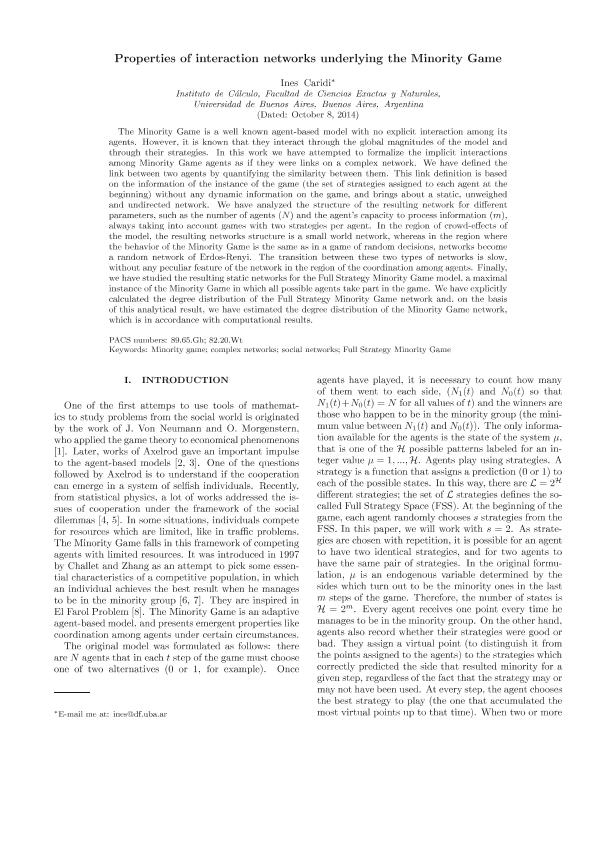Mostrar el registro sencillo del ítem
dc.contributor.author
Caridi, Délida Inés

dc.date.available
2018-01-12T18:38:23Z
dc.date.issued
2014-11
dc.identifier.citation
Properties of interaction networks underlying the minority game; American Physical Society; Physical Review E: Statistical, Nonlinear and Soft Matter Physics; 90; 5; 11-2014; 1-12; 052816
dc.identifier.issn
1539-3755
dc.identifier.uri
http://hdl.handle.net/11336/33090
dc.description.abstract
The minority game is a well-known agent-based model with no explicit interaction among its agents. However, it is known that they interact through the global magnitudes of the model and through their strategies. In this work we have attempted to formalize the implicit interactions among minority game agents as if they were links on a complex network. We have defined the link between two agents by quantifying the similarity between them. This link definition is based on the information of the instance of the game (the set of strategies assigned to each agent at the beginning) without any dynamic information on the game and brings about a static, unweighed and undirected network. We have analyzed the structure of the resulting network for different parameters, such as the number of agents ( N ) and the agent's capacity to process information ( m ) , always taking into account games with two strategies per agent. In the region of crowd effects of the model, the resulting networks structure is a small-world network, whereas in the region where the behavior of the minority game is the same as in a game of random decisions, networks become a random network of Erdos-Renyi. The transition between these two types of networks is slow, without any peculiar feature of the network in the region of the coordination among agents. Finally, we have studied the resulting static networks for the full strategy minority game model, a maximal instance of the minority game in which all possible agents take part in the game. We have explicitly calculated the degree distribution of the full strategy minority game network and, on the basis of this analytical result, we have estimated the degree distribution of the minority game network, which is in accordance with computational results.
dc.format
application/pdf
dc.language.iso
eng
dc.publisher
American Physical Society

dc.rights
info:eu-repo/semantics/openAccess
dc.rights.uri
https://creativecommons.org/licenses/by-nc-sa/2.5/ar/
dc.subject
Complex Systems
dc.subject
Social And Economic Systems
dc.subject.classification
Astronomía

dc.subject.classification
Ciencias Físicas

dc.subject.classification
CIENCIAS NATURALES Y EXACTAS

dc.title
Properties of interaction networks underlying the minority game
dc.type
info:eu-repo/semantics/article
dc.type
info:ar-repo/semantics/artículo
dc.type
info:eu-repo/semantics/publishedVersion
dc.date.updated
2018-01-11T19:35:47Z
dc.journal.volume
90
dc.journal.number
5
dc.journal.pagination
1-12; 052816
dc.journal.pais
Estados Unidos

dc.description.fil
Fil: Caridi, Délida Inés. Universidad de Buenos Aires. Facultad de Ciencias Exactas y Naturales. Instituto de Cálculo; Argentina. Consejo Nacional de Investigaciones Científicas y Técnicas; Argentina
dc.journal.title
Physical Review E: Statistical, Nonlinear and Soft Matter Physics

dc.relation.alternativeid
info:eu-repo/semantics/altIdentifier/doi/http://dx.doi.org/10.1103/PhysRevE.90.052816
dc.relation.alternativeid
info:eu-repo/semantics/altIdentifier/url/https://journals.aps.org/pre/abstract/10.1103/PhysRevE.90.052816
Archivos asociados
